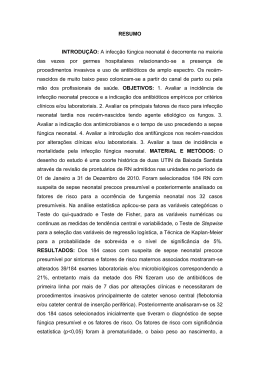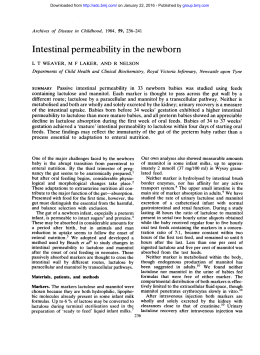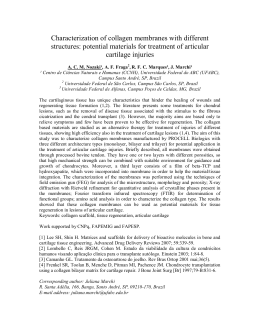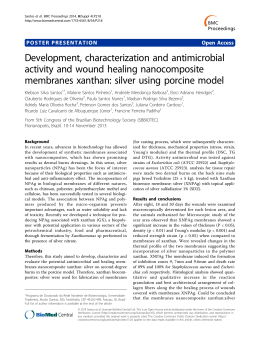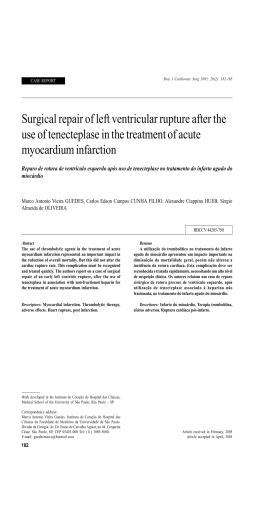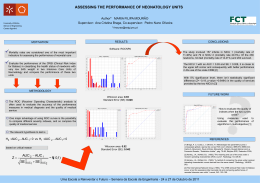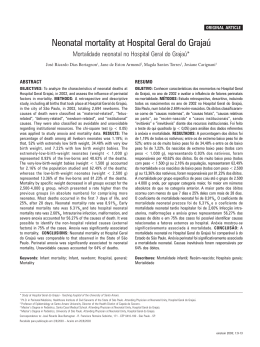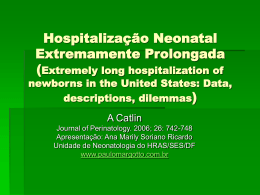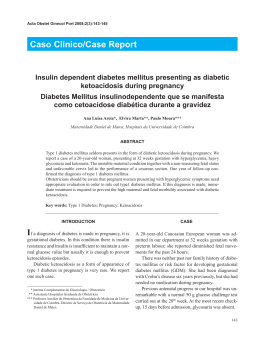REVIEW ARTICLE Obstetric interventions in preterm birth: a literature review and therapeutic update Intervenções obstétricas no parto pré-termo: revisão da literatura e atualização terapêutica Mário Dias Corrêa Júnior1, Evilane do Carmo Patrício2, Lara Rodrigues Félix 2 DOI: 10.5935/2238-3182.20130051 ABSTRACT Prematurity is an important theme that impacts greatly both public and individual health. It is still the highest cause of morbimortality in the perinatal period and its consequences include potentially severe immediate and late effects. Although there are still severe limitations to the early identification of preterm labor as well as in the measures to avoid complications, many advances have been made in terms of assistance to pregnant mothers and neonates, including more widespread neonatal intensive care centers. This review aims to present therapeutic measures that can minimize the consequences of preterm delivery. Whenever indicated, medication for tocolysis, fetus lung maturation, neural protection, and infection prevention must be prescribed, given that any intervention capable of improving fetal prognosis has relevant social, psychological and financial impact on affected families. 1 Associate Professor, Department of Obstetrics and Gynecology, School of Medicine, Universidade Federal de Minas Gerais-UFMG. Belo Horizonte, MG – Brazil. 2 Resident gynecologist and obstetrician, Hospital das Clínicas, UFMG. Belo Horizonte, MG – Brazil. Key words: Obstetric Labor, Premature; Infant, Premature; Premature Birth; Abruptio Placentae; Antibiotic Prophylaxis; Maternal Mortality. RESUMO A prematuridade constitui-se em tema de grande repercussão em saúde pública e individual. Persiste como a maior causa de morbimortalidade perinatal e suas consequências envolvem efeitos imediatos e tardios potencialmente graves. Existe ainda grande limitação na identificação precoce dos casos de trabalho de parto pré-termo quanto à adoção de medidas capazes de prevenir suas complicações, entretanto, muitos avanços foram obtidos em função de como melhor oferecer assistência à gestante e ao recémnascido, além da difusão de centros de terapia intensiva neonatal. Esta revisão objetiva apresentar as medidas terapêuticas capazes de minimizar as consequências do parto pré-termo. Devem ser empregadas, sempre que houver indicação, as medicações para tocólise, maturação pulmonar fetal, neuroproteção e prevenção de infecções, uma vez que qualquer intervenção capaz de melhorar o prognóstico fetal possui forte impacto social, psicológico e financeiro nas famílias afetadas por esse problema. Palavras-chave: Trabalho de Parto Prematuro; Prematuro; Nascimento Prematuro; Descolamento Prematuro da Placenta; Antibioticoprofilaxia; Mortalidade Materna. Submitted: 07/08/2013 Approved: 07/22/2013 INTRODUCTION Prematurity, in spite of the great scientific and technological advances of the last decades, persists as an important medical problem. It is the major cause of perinatal morbidity and mortality and accounts for 75% of deaths in this period.1 Its consequences involve immediate and late effects, such as permanent physical and mental Institution: School of Medicine, Universidade Federal de Minas Gerais – UFMG Belo Horizonte, MG – Brazil Corresponding Author: Mario Dias Corrêa Junior E-mail: [email protected] Rev Med Minas Gerais 2013; 23(3): 315-321 315 Obstetric interventions in preterm birth: a literature review and therapeutic update damages. Approximately 50% of neurological sequelae can be attributed to prematurity.1 Due to its major repercussions in terms of public health and in the quality of life of affected families, it constitutes one of the most studied topics in Obstetrics and Perinatology. Predicting its occurrence is a hard task; however, there have been significant breakthroughs in therapies able to reduce its consequences. Approximately 45% of prematurity cases occur in preterm deliveries with intact amniotic sacs; 30% due to premature rupture of the amniotic sac, and in 25% a preterm delivery is performed to address maternal and/or fetal complications.2 ■■ ■■ MAIN COMPLICATIONS OF PREMATURE NEWBORNS The risk of developing perinatal complications is directly proportional to the decline in gestational age and weight at birth.3 Children born before the 25th gestational week have high mortality rates (around 50%), and in some units this gestational age is considered the limit for fetal viability. Some of the more relevant complications related to prematurity are: ■■ hypothermia: fast heat loss in preterm newborns because of the relatively large body surface area and the incapacity to generate enough heat. It can contribute to the occurrence of metabolic disorders such as hypoglycemia or acidosis; ■■ respiratory complications: main causes of hospitalization in neonatal units. Include respiratory distress syndrome (caused by surfactant deficiency), bronchopulmonary dysplasia (a late complication frequently found in extremely low birth weight neonates), and apnea of prematurity (occurring in 25% of premature newborns); ■■ cardiovascular complications: include persistent arterial duct (affecting 30% of extremely low birth weight newborns) and systemic hypotension. These neonates are not ready for the transition from fetal to extrauterine circulation, which requires progressive adaptations that are essential for correct cardiovascular performance; ■■ necrotizing enterocolitis: has several causes and is determined by intestinal ischemia and resulting mucous membrane lesion, edema, ulceration, and passage of gas and bacteria through the in- 316 Rev Med Minas Gerais 2013; 23(3): 315-321 ■■ testinal wall. It occurs in 2 to 10% of extremely low birth weight newborns and is associated with an important increase in mortality; late sepsis: defined through positive blood-culture associated with clinical signs suggesting infection. It generally occurs after the third day of life and is related to fetal immunological immaturity and infection-predisposing factor such as incubation and prolonged intravascular access and necrotizing enterocolitis. Moreover, fungal infection, especially candidiasis, is responsible for 9% of late sepsis cases. It is associated with the increased probability of delay in neurological development and growth restriction; retinopathy of prematurity: proliferative retinal vascular disease of premature newborns. It can be aggravated by hypoxia, hyperoxia, blood transfusions, or infections. It occurs especially from around 34 weeks of corrected age and has spontaneous remission in most children. However, patients with severe untreated retinopathy are at high risk of developing some sort of visual impairment; intraventricular hemorrhage: caused by birth traumas and constitutes an important cause of brain injury in premature neonates. It is associated with significant long-term neurological sequelae. Its incidence has declined since the 1980s; however, it remains a serious problem due to the improved survival of extremely premature neonates. It is more frequent among children born before 32 gestational weeks or children weighing less than 1,500g at birth. Tocolysis Suppression methods are justified only when the diagnosis of labor is verified. Making a correct diagnosis of preterm labor is not always easy, however, and medical history and physical examination are always the first step. The occurrence of at least two contractions in 10 minutes of at least 25 seconds each appears to be a good diagnostic parameter. Modifications in the cervical canal (effacement and dilation), the height of fetal pole and evaluation of membrane integrity are also important. Defining the appropriate gestational age for suppressing preterm labor is still controversial. The 34th week is considered to be the upper limit, but suppression can be accepted up to the 36th week of pregnancy. The lower limit is also questioned, considering that Obstetric interventions in preterm birth: a literature review and therapeutic update neonates with more than 20-22 weeks can be viable. The decision to suppress delivery at that stage varies according to the protocols at each service, considering that not all preterm labors must be suppressed and that there are important obstetric contraindications. The following contraindications are considered absolute: intrauterine infection, rupture of the amniotic membranes with suspected infection, placental insufficiency with chronic fetal distress (IUGR or oligohydramnios), fetal malformations incompatible with extrauterine life, multiple malformations, severe maternal diseases, demonstrated fetal death, and proven fetal lung maturity. Premature rupture of the amniotic membranes (PROM) is mainly cited a relative contraindication. In such cases, labor can be delayed for 72 hours, which is considered enough time for fetal lung maturation after membranes are disrupted. Tocolysis after PROM, however, can be harmful to the newborn and can increase maternal infectious complications. Before opting for suppression of labor, it is important to assess the real risk of childbirth and the possibilities of succeeding with suppression methods. To this end, a well-consolidated risk index based on the sum of some important variables can be used (Table 1). Table 1 - Index of risk of preterm labor Test result Assigned values 0 1 2 Position of the cervix Posterior Intermediate Central Effacement Immature 30 to 50% ≥ 50% None 2 to 4 cm > 4cm High (movable) Medium (fixed) Low Amniotic sac Non-formed Formed Herniated Contractions < 1 / hour 1 / 10’/ 15” ≥ 2 /10'/25" Dilation Height of presentation The total score can help define the risk of imminent preterm labor, as follows: ■■ less than 6: suppression methods are not justified; ■■ 6 to 10: imminent risk and suppression methods should be initiated immediately as long as there are no contraindications; ■■ above 10: labor in progress, hence suppression is no longer justified. Suppression should be done with the patient already hospitalized. Intravenous hydration is recommended as long as hypovolemia is associated with increased uterine activity.7 Fluids should be administered with caution because of the risk of fluid overload and pulmonary edema.8 Tocolytic agents must also be employed; their main goal is to stop the pattern of uterine contractions, with the possibility of inducing fetal maturation or transferring the woman to a tertiary referral center. They thereby contribute directly or indirectly to reducing perinatal mortality. The tocolytic agents employed to suppress preterm labor can be divided into various groups (Table 2). There is no ideal tocolytic; all have low effectiveness and several side effects. However, even a short period of suppression is enough for other measures to be taken, such as steroid use and referral to a center with a Neonatal Intensive Care Unit in order to improve the outcome of premature newborns. Since tocolytics have similar efficacy, other factors such as incidence of side effects and cost must be taken into consideration. Thus, the first choices are usually nifedipine and indomethacin. In pregnancies below 32 weeks and in cases of polyhydramnios, indomethacin appears to be more effective than nifedipine.9 Combined use of drugs is discouraged due to risk of potentiation of side effects with no corresponding improved results. Use of tocolytics as prophylactic measures or as maintenance therapy after suppression has not shown good results and is not recommended. Use of progesterone after the suppression of preterm labor has shown good results. 17-alpha-hydroxyprogesterone caproate can be used through intramuscular injection in hospitalized patients in order to suppress preterm labor between 25 and 34 weeks. It can prolong gestation with high birth rates after 37 weeks and higher average weight at birth.10 The same results can be obtained using progesterone in a 400 mg intravaginal dose, with the additional advantage of reduced incidence of respiratory discomfort. Despite these favorable results, there are still very few studies available, and no consensus on the best dosage of progesterone to be used, so further research is needed before their use is recommended for this purpose. USE OF ANTIBIOTICS Infections are often involved in triggering preterm labor and there is some evidence that antibiotic prophylaxis can reduce their incidence without real benefits in prolonging gestation or reducing neonatal morbidity and mortality, which makes them useful only in reducing the rates of maternal infections.12 Rev Med Minas Gerais 2013; 23(3): 315-321 317 Obstetric interventions in preterm birth: a literature review and therapeutic update Table 2 - Main drugs used to suppress preterm labor Class/Use Representatives Stimulators of the beta adrenergic receptors (Uterine muscle relaxation) Inhibitors of prostaglandin synthesis and release Oxytocin receptor antagonists Calcium channel blocker (Reduce vascular resistance and myometrial activity) Magnesium Sulfate (Suppression of neurotransmission to womb’s smooth-muscle and direct effect on myometrial cells) Nitric Oxide donors (myometrial muscle relaxation) Several side effects (maternal and fetal tachycardia, palpitation, dyspnea, tremors, and hyperglycemia). Do not reduce neonatal morbidity and mortality Indomethacin To be used only in gestations <32 weeks and for up to 72 hours. Risk of oligohydramnions, early closure of the arterial duct, intraventricular hemorrhage, necrotizing enterocolitis and hyperbilirubinemia. Atosiban Low incidence of side effects. High cost Nifedipine Low cost and fast action. Contraindicated for patients using magnesium sulfate or with hypotension. Magnesium Sulfate Risk of central nervous system depression and high rates of side effects. Nitroglycerin Fast action. Risk of hypotension and cardiovascular effects. Difficult to handle. Table 3 - Main drugs used to suppress preterm labor and their dosage Drug Attack Maintenance Nifedipine 30mg PO 10mg 6/6h Salbutamol 10-48mcg/min EV 10-48mcg/min EV 100mg R or 50mg PO 25 to 50mcg 4/4h for 2 days Indomethacin MgS04 Atosiban 4g at 20% EV 6.75mg EV 1 to 3g/h EV 300mg/min – 3h 100mg/min – 45h Antibiotic prophylaxis is recommended only for preventing neonatal infection by group B streptococcus (GBS) and when faced with the possibility of preterm labor, unless vaginal and rectal cultures are negative for the last five weeks. It must be made with crystalline penicillin, at a loading dose of 5,000,000 IU intravenously, and then 2,500,000 UI every four hours until delivery. It should be kept for 48 hours if labor is suppressed. GBS cultures must be collected, whenever possible, at patient admission. In case of negative result and if the patient goes into labor within the next five weeks, new course of treatment is not necessary. RUPTURED AMNIOTIC SAC Premature rupture of membranes is responsible for approximately 25 to 35% of cases of preterm labor and is associated with short latency period until childbirth and complications such as compression of the umbilical cord and chorioamnionitis. Bacterial colonization of the respiratory tract constitutes one of the main predisposing factors, resulting in release of local pro-inflammatory enzymes that “weaken” 318 Rev Med Minas Gerais 2013; 23(3): 315-321 Considerations Salbutamol Ritodrine Terbutaline the membranes and cause its premature rupture. Amniotic fluid culture or C-reactive protein assays in asymptomatic preterm amniorrhexis identifies bacterial colonization rates of 30-50%,14 which makes antibiotic therapy beneficial. It can, moreover, help modulate maternal and fetal inflammatory response, which triggers preterm labor and neonatal morbidity. The recommendation, in that case, is intravenous antibiotic prophylaxis for 48 hours with ampicillin or erythromycin, then on for a week, both drugs per os. This measure improves neonatal prognosis and reduces mortality rates, acute respiratory distress, early sepsis, increased intraventricular hemorrhage, and necrotizing enterocolitis, besides reducing the rate of amnionitis and possibly prolonging pregnancy for up to a week. Broad-spectrum antibiotic therapy associated with intrapartum prophylaxis for patients with positive GBS culture, faced with premature rupture of membrane and gestational age ≤ 32 weeks prolongs pregnancy, reduces the rates of infection and morbidity related to gestational age, with no increase in perinatal complications. The ORACLE I17 study also assessed the benefits of using antibiotics in preterm premature rupture of membrane and involved 4,826 pregnant women with premature rupture of membranes and gestational age < 37 weeks. The randomized trial defined a 10-day course of erythromycin (n = 1,197), amoxicillin + clavulanate (n = 1.212), a combination of both (n = 1,192) or placebo (n = 1225). Findings were short prolongation of gestation (48 hours) in the group treated with erythromycin, and reduced need for oxygen therapy among newborns, in addition to a low rate of positive blood cultures. In the group subjected to treatment with amoxicillin + clavulanate there was prolonga- Obstetric interventions in preterm birth: a literature review and therapeutic update tion of gestation for up to seven days and reduced need for oxygen therapy among newborns, but with increased rates of necrotizing enterocolitis. This was the only major study of conservative treatments in cases of premature rupture of membranes that assessed the long-term evolution of neonates. The assessment made with the parents after seven years of follow-up showed no significant differences between the group that used antibiotics and controls regarding these children’s medical conditions, behavioral changes, or functional impairment. Antibiotic therapy in premature rupture of membranes should be followed in cases for whom prolongation of gestation has the potential of reducing prematurity-related morbidities and when the risk of neonatal death is higher than the reported 1-2% risk of fetal demise on expectant management. This treatment should include broad-spectrum agents and be employed at first intravenously, continuing for up to seven days if delivery does not occur.14 CORTICOTHERAPY Corticotherapy has several benefits for the premature newborn, with no significant undesirable effects. Its main benefits consist in reducing the incidence and severity of respiratory depression, intraventricular hemorrhage, necrotizing enterocolitis, and neonatal mortality. Corticotherapy improves pulmonary, circulatory, and nervous functions as well as Apgar scores. Patients who are to undergo tocolysis with gestational age between 24 and 34 weeks should receive 2 doses of 12 mg intramuscular betamethasone at a 24-hour interval between them, or a total of 4 doses of 6 mg intramuscular dexamethasone every 12 hours. Corticotherapy is recommended upon premature rupture of membranes, before 32 gestational weeks to reduce the risk of acute respiratory distress and perinatal morbidity and mortality. Its effectiveness in premature rupture of membranes between 32 and 34 gestational weeks is controversial, but may it be beneficial especially in face of fetal lung immaturity.18 Corticotherapy also reduces neonatal mortality rates due to acute respiratory distress syndrome and intraventricular hemorrhage, with no significant increase in the rates of maternal infection.19 The maximum effect of corticotherapy occurs between 48 hours and seven days after onset, but there are benefits even if the birth occurs before 48 hours (eight to 15 hours).20 No reduction in neonatal mortality has been observed with repetition of doses of corticosteroids every 7 or 14 days. Administration of multiple doses of corticosteroids is associated with reduced weight at birth and cranial circumference; however, a single rescue dose is recommended if corticotherapy took place more than two weeks previously, if gestational age is less than 32 6/7 weeks and if there is risk that labor might occur in the next seven days.22 MAGNESIUM SULFATE FOR NEUROPROTECTION Among the most feared complications of prematurity are neurological sequelae. Magnesium sulfate appears to possess neuroprotective effects on the fetus and to reduce the incidence of hypoxia-related lesions, especially in gestations of less than 28 weeks because it stabilizes cerebral vessel membranes. Its use for suppressing preterm labor is associated with low rates of cerebral palsy in newborns.23 It must be used intravenously at a loading dose of 6g and followed by infusions of 2g per hour for at least three hours.23 DELIVERY METHOD The biggest concerns regarding delivery methods are the risks of birth trauma, hypoxia, infection, and fetal intraventricular hemorrhage, since obstetric assistance has a decisive role in premature newborns’ neuropsychomotor development. The decision for the best method of delivery must involve an assessment of factors such as gestational age, estimated fetal weigh, fetal presentation, integrity of amniotic membranes, and the possibility of monitoring fetal conditions properly. Serial transcranial ultrasound of low birth weight neonates for postpartum cerebral hemorrhage screening shows that the incidence of bleeding is similar in both abdominal and vaginal births. Immediate hemorrhage is higher among vaginal birth neonates while late hemorrhage is higher among C-section neonates. In case of vaginal birth, wide episiotomy is recommended since it can reduce the duration of fetal expulRev Med Minas Gerais 2013; 23(3): 315-321 319 Obstetric interventions in preterm birth: a literature review and therapeutic update sion as well as facilitate fetus detachment, possibly decreasing the incidence of intraventricular hemorrhage. Episiotomy should also be performed aiming to minimize head trauma, formation of caput succedaneum and rupture delay. The amniotic sac is believed to act as mechanical protection for the fetal cephalic pole. There is no justification for caesareans to be performed routinely as a protective measure against intrapartum fetal injury. It has been observed that rates of fetal injuries are similar to those of vaginal births, especially for premature fetuses, although at first glance this type of delivery is considered less traumatic. The transabdominal route is not risk-free, especially considering difficulties in extracting the premature fetus and the frequent need for hysterectomy, which increases the rate of intrapartum bleeding and puerperal complications. CONCLUSIONS There has been significant progress in the reduction of fetal mortality due to preterm labor as a result of intrapartum measures that can prevent future complications of prematurity, of better childbirth assistance and, in particular, of improvements in neonatal assistance and the dissemination of neonatal intensive care centers. On the other hand, little progress has been made as regards the prevention of preterm labor, the ideal intervention for this public health concern. All efforts must be focused on further clarification of its pathophysiology and on measures to reduce its incidence. Medication for tocolysis, fetal lung maturation, neuroprotection, and prevention of infections should always be employed since any measure that can improve fetal prognosis has strong social, psychological, and financial impacts on families affected by this problem (Table 4). Table 4 - Follow up evidence for gestations at risk of preterm labor Objective Treatment Intervention Level of evidence Level of recommendation Tocolytics have little but significant effect (48 hours to 7 days inhibition) 1A A Corticotherapy reduces neonatal morbidity and mortality 1A A Antibiotic prophylaxis does not improve neonatal morbidity and mortality 1A A Group B Streptococcus prophylaxis can be beneficial 1A A MgS04 appears to have neuroprotective effect below 28 weeks 1A A REFERENCES 1. Goldenberg RL, Culhane JF, Iams JD, Romero R. Epidemiology and causes of preterm birth. Lancet. 2008; 37:75-84. 2. Tucker JM, Goldenberg RI, Davis ROI, et al. Etiologies of preterm birth in an indigent populations: it’s prevention a logical expectation? Obstet Gynecol. 1991; 97:343-8. 3. Silveira MF, Santos IS, Barros AJD, Matijasevich A, Barros FC, Vitcora CG. Increase in preterm birth in Brazil: review of population based studies. Rev Saúde Pública. 2008; 42:1-7. 4. Iams JD, Goldenberg RL, Meis PJ, Mercer BM, Moawad A, Das A, et al. The length of the cervix and the risk of spontaneous preterm delivery. N Engl J Med. 1996; 334:567-72. 5. Armstrong J. 17 Progesterone for preterm birth prevention: a potential 2 billion dollar opportunity. Am J Obstet Gynecol. 2007; 196:194-5. 6. Mercer BM. Is there a role for tocolytic therapy during conservative management of preterm premature rupture of the membranes? Clin Obstet Gynecol. 2007; 50: 487-96. 7. Hearne AE, Nagey DA.Therapeutic agents in preterm labor.Tocolytic agents. Clin Obstet Gynecol. 2000; 43:787-801. 320 Rev Med Minas Gerais 2013; 23(3): 315-321 8. Freda MC, Devore N. Should hydration be the first line of defense with threatened preterm labor? A critical review of literature. J Perinatol. 1996; 61:239-44. 9. Haas DM, Imperiale TF, Kirkpatrick PR, Klein RW, Zollinger TW, Golichowski AM.Tocolytic therapy: a meta-analysis and decision analysis. Obstet Gynecol. 2009; 113:585-94. 10. Facchinetti F, Paganelli S, Comitini G, Dante G, Volpe A. Cervical length changes during preterm cervical ripening: effects of 17-alpha-hydroxyprogesterone caproate. Am J Obstet Gynecol. 2007; 196:453.e1-4 11. Borna S, Sahabi N. Progesterone for maintenance tocolytic therapy after threatened preterm labour: a randomised controlled trial. Aust N Z J Obstet Gynaecol. 2008; 48:58-63. 12. King J, Flenady V. Prophylactic antibiotics for inhibiting preterm labour with intact membranes. In: The Cochrane Library, Issue 1, 2009. 13. Centers of Disease Control and Prevention. Prevention of perinatal group B streptococcal disease: Revised Guidelines from CDC, 2002. [Cited 2013 Jan 21]. Available from: http://www.cdc.gov. 14. Mercer B. Antibiotics in the management of PROM and preterm labor. Obstet Gynecol Clin N Am. 2012; 39:65-76. Obstetric interventions in preterm birth: a literature review and therapeutic update 15. Simhan HN, Canavan TP. Preterm premature rupture of membranes: diagnosis, evaluation and management strategies. BJOG: Int J Obstet Gynaecol. 2005; 112( Suppl 1):32-7. 20. Ikegami M, Polk D, Jobe A. Minimum interval from fetal betamethasone treatment to postnatal lung response in preterm lambs. Am J Obstet Gynecol. 1996; 174: 1408-13. 16. Mercer BM, Miodovnik M, Thurnau GR, et al. Antibiotic therapy for reduction of infant morbidity after preterm premature rupture of the membranes. A randomized controlled trial. National Institute of Child Health and Human Development MaternalFetal Medicine Units Network. JAMA. 1997; 278:989-95. 21. Bonanno C, Wapner RJ. Antenatal corticosteroid treatment: what’s happened since Drs Liggins abd Howie? Am J Obstet Gynecol. 2009; 200:448-57. 17. Kenyon, SL, Taylor DJ, Tarnow- Mordi W, ORACLE Collaborative group. Broad-Spectrum antibiotics for preterm prelabor rupture of fetal membranes: the ORACLE I randomised Trial. ORACLE Collaborative Group. Lancet. 2001 Jul 14; 358(9276):156. 18. The American College of Obstetricians and GynecologistsACOG Commitee Opinion. Obstet Gynecol 2011;117:1240-1 19. Crowley P. Prophylactic corticosteroids for preterm birth. In: The Cochrane Library, Issue 1, 2009. 22. Garite TJ, Kurtzman J, Maurel K, Clark R. Impact of a ‘rescue course’ of antenatal corticosteroids: a multicenter randomized placebo-controlled Trial. Obstetric Collaborative Research Network. Am J Obstet Gynecol. 2009; 200:248.e1-248.e9. 23. Rouse DJ, Hirtz DG, Thom E, Varner MW, Spong CY, Mercer BM, et al. A randomized, controlled trial of magnesium sulfate for the prevention of cerebral palsy. N Engl J Med. 2008 Aug 28;359(9):895-905. 24. Shaver DC, Bada HS, Korones SP, et al. Early and late intraventricular hemorrhage; the role of obstetric factors. Obstet Gynecol. 1992; 80:831-5. Rev Med Minas Gerais 2013; 23(3): 315-321 321
Download

